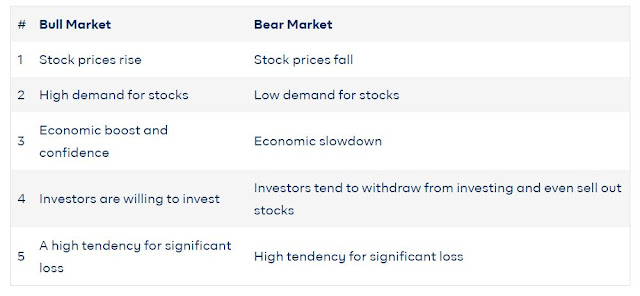A short story about the Bull and Bear Market
In the land of Investo, two friends, Bull and Bear, had different views on the stock market. Bull was optimistic and saw opportunities, while Bear was cautious and skeptical. Bull’s investments succeeded, attracting investors, but Bear faced setbacks. When the economy declined, Bear felt vindicated, selling stocks to reduce losses. However, the market improved again, and Bull reinvested, attracting more investors.
This teaches a valuable lesson about market fluctuations, reminding investors to approach investment with balance, optimism, and caution.
Understanding the fundamental differences between these market conditions is crucial for investors. In this article, we answer some questions about bull and bear markets, while shedding light on their differences.
What is a Bull Market?
A bull market is when the prices of stocks or other financial assets are on the rise for an extended period of time.
During a bull market, people are optimistic about investing. Investor confidence is high, leading to increased buying activity as investors expect continued growth and higher returns. Positive economic indicators and expectations of future growth typically drive this upward momentum.
What is a Bear Market?
A bear market is the opposite of a bull market. It is when the stock market is falling i.e. a prolonged period of declining prices for stocks or other assets.
In a bear market, people are pessimistic about investing. Investor sentiment is negative, leading to increased selling activity. Investors also might become reluctant to invest due to the expectation of further losses. This downward trend is often driven by factors such as economic uncertainty, pessimistic outlooks, or negative news events.
Differences between Bull and Bear Market
Why do Bull Markets become Bear Markets?
Bull markets and bear markets are terms used to describe the overall direction of a financial market. When there is an economic downturn in the country, such as a spike in unemployment or recession, it becomes difficult to maintain the rising stock prices and, as a result, develop fear in investors and prevent them from taking investment risks.
The transition from a bull market to a bear market can occur due to several factors:
Overvaluation: Bull markets often witness a period of excessive optimism and investor euphoria, leading to overvaluation of assets. When prices reach unsustainable levels, it can trigger a correction or reversal in market sentiment, leading to a bear market.
Economic factors: Changes in economic conditions, such as slowing economic growth, rising interest rates, inflationary pressures, or geopolitical tensions, can dampen investor confidence and trigger a shift from a bull to a bear market.
Market psychology: Market sentiment and investor psychology are key to the direction the market takes. In a bull market, investors may exhibit a herd mentality, driving prices higher. However, if sentiment turns negative due to fear, uncertainty, or panic, it can lead to a rapid change in market direction, resulting in a bear market.
Corporate earnings: Bull markets are often supported by strong corporate earnings growth. However, if companies begin reporting disappointing earnings, deteriorating fundamentals, or negative outlooks, it can undermine investor confidence and contribute to a shift toward a bear market.
Policy changes: Government policies, central bank actions, or regulatory changes can impact market dynamics. Shifts in monetary policy, such as tightening of interest rates or reducing liquidity, can affect borrowing costs, business investment, and consumer spending, potentially leading to a transition from a bull to a bear market.
External Events: Unexpected events, such as natural disasters, political instability, or major geopolitical conflicts, can disrupt markets and trigger a shift in sentiment.
It’s important to note that the transition from a bull market to a bear market is rarely attributed to a single cause but rather the culmination of various economic, financial, and psychological factors that collectively impact investor sentiment and market behaviour.
How long does a Bull Market last?
The longest bull market in history lasted from March 2009 to February 2020. It occurred due to low-interest rates, strong earnings growth, and investors’ optimism. A bull market can last for months or years. Predicting the exact length of a bull market is challenging, and market cycles can be subject to fluctuations and unexpected changes.
How long does a Bear Market last?
The longest bear market in history is the US Great Depression bear market which lasted from October 1929 till June 1932. It occurred due to the stock crash in 1932, followed by an economic downturn. Bear markets can last anywhere from a few months to a couple of years. Some bear markets have been relatively short-lived, lasting less than a year, while others have persisted for several years.
Which is better: Bull or Bear market?
It depends on individual preferences and investment strategies. A bull market typically offers rising prices and optimistic sentiment, while a bear market can present opportunities for value investing and potentially lower entry points for long-term investors.
While it looks more profitable to invest during a bull market, investing in a bear market is also beneficial, especially with a defensive strategy. A defensive investment strategy helps you to navigate the market downturn by increasing the allocation of bonds and stocks while reducing the allocation of a growth stock.
Bottom Line
Bull markets and bear markets represent opposite phases in financial markets. While a bull market is when there is a rise in stock prices or other financial assets, economic growth, and optimism, a bear market represents a decline in stock prices, economic downturn, and pessimism.
By knowing the difference and characteristics of the two market phases and how they work, it is easier for investors to navigate through with confidence. This could be by either seizing growth and expansion opportunities during a bull market or adopting defensive measures during a bear market. Either way, understanding the dynamics help investors make informed decisions to achieve their long-term financial goals.
Source: Cowrywise


No comments:
Post a Comment